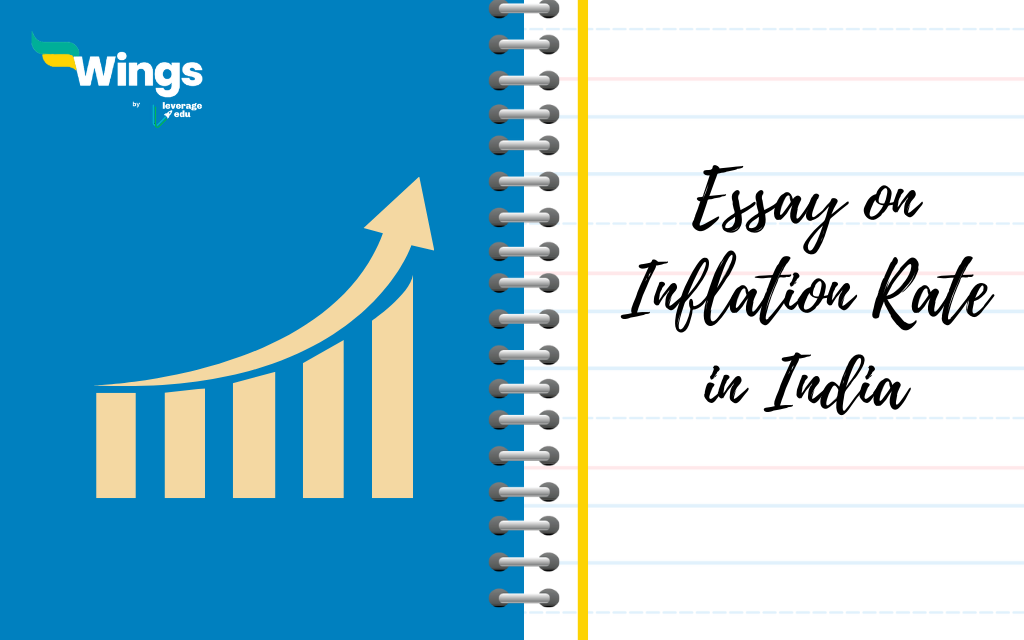On 24 February 2022, Russia invaded Ukraine. Although this military conflict was limited to Eurasia only, it had a profound impact on the movement of goods all over the world. India, just like other countries, too, faced some economic disturbances. However, the economic policies of the RBI, backed by the Indian government, were able to mitigate the inflation rate in India. An essay on the Inflation rate in India can be a great way for students to share their thoughts, experiences, and ideas on this topic. On this page, we have discussed an essay on the inflation rate in India for students.
Quick Read: Essay on the Role of Youth in Nation Building
Contents
Essay on Inflation Rate in India in 500 Words
Inflation is the gradual rise in prices, meaning your money buys a little less over time. Imagine your favourite chips costing more next year! COVID-19 lockdowns caused a spike in inflation, making everyday items more expensive. While things are improving with inflation around 5% (April 2024), understanding inflation is key to navigating India’s economy and its impact on our daily lives.
Current Inflation Rate in India
April 2024 brings some encouraging news on the inflation front. India’s overall inflation rate dipped to 5.0%, continuing its downward trend and staying comfortably within the Reserve Bank of India’s target range. This indicates a continued slowdown in price increases compared to previous months. However, the progress is gradual, with the decrease from March being minimal.
Additionally, a concerning disparity persists between rural and urban areas. While inflation sits at 4.78% in cities, it hits rural residents harder at 5.34%, a gap that hasn’t narrowed since December 2023. Food prices also remain a point of concern, with inflation hovering around 8.66%. So, while the overall trend in inflation is positive, the uneven impact on rural areas and the continued pressure from food price hikes require ongoing monitoring.
| Year | Average Inflation Rate | Annual Change |
| 2024 | 5.0% | -0.4% |
| 2023 | 5.49% | -1.21% |
| 2022 | 6.5% | 1.57% |
| 2021 | 5.0% | -1.49% |
| 2020 | 6.0% | 2.89% |
| 2019 | 5.0% | -0.21% |
| 2018 | 4.0% | 0.61% |
| 2017 | 3.5% | -1.62% |
| 2016 | 4.0% | 0.04% |
| 2015 | 6.0% | -1.76% |
| 2014 | 6.7% | -3.35% |
This table shows India’s average annual inflation rate from 2014 to April 2024, highlighting a period of fluctuation with a recent trend towards stability.
Types of Inflation in India
There are two main types of inflation:
- Cost-Push Inflation: Higher production costs (wages, materials) lead to businesses raising prices.
- Demand-Pull Inflation: Too much money chasing too few goods leads to higher prices.
- Hyperinflation: out-of-control price spikes fueled by money printing or economic chaos.
- Built-in Inflation: Wages and prices spiral up as everyone expects inflation to keep rising.
Quick Read: Essay Topics for in English
Inflations vs Economic Growth in India
A rising economy like India’s is often thought to benefit from a small amount of inflation, perhaps 2–4%. Spending is encouraged, which helps businesses operate and generates employment. High inflation, though, like in the COVID era, can be a nightmare. It eats away at people’s money and makes planning harder for businesses.
The central bank of India, the Reserve Bank of India (RBI), attempts to balance on a thin line. To manage inflation, they employ instruments such as interest rates. View interest rates as a tap that manages the flow of financial resources. Higher interest rates encourage people to save more and spend less, which lowers inflation by making borrowing more expensive.
Conclusion
An essential component of India’s economic strategy is inflation. A strong and stable economy depends on keeping inflation under control, even though a little bit of it is acceptable. We can appreciate the RBI’s efforts to control prices and guarantee a prosperous economic future for India by knowing the different types of inflation and how they interact with economic growth.
10-Lines Essay on Inflation in India
- Inflation, the rising cost of goods and services, is a concern for India’s economy.
- Factors like global oil prices, supply chain disruptions, and increased government spending can contribute.
- This erodes purchasing power, especially for essential items.
- While the Reserve Bank of India works to control inflation, it can impact daily life, strain budgets, and hinder economic growth.
- Recent data shows a decline in inflation, but core inflation in certain sectors remains high.
- This means that some everyday necessities may still see price increases.
- The government faces a challenge in balancing inflation control with supporting vulnerable populations.
- India must balance promoting its post-pandemic economy with limiting inflation.
- It will be important to observe whether these initiatives stabilise the country’s economic environment in the upcoming months.
- Close monitoring and potential policy adjustments might be necessary to ensure price stability and a healthy economic future.
FAQs
Ans. India battles inflation fueled by global factors and spending. RBI fights to curb it, but everyday costs strain budgets and growth. Long-term solutions are needed for stability.
Ans. India’s current inflation rate as of April 2024 is 5%.
Ans. The Reserve Bank of India (RBI) and the Indian government work together to set the country’s inflation objective. The Reserve Bank of India is in charge of using monetary policies to manage inflation, even if the government sets an inflation target once every five years.
Popular Essay Topics in English
For more information on such interesting topics, visit our essay writing page and follow Leverage Edu.
 One app for all your study abroad needs
One app for all your study abroad needs














